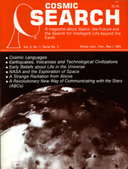![[NAAPO Logo]](../../Images/NAAPOsm.jpg) North American AstroPhysical Observatory (NAAPO)
|
|
Off the Shelf
By: Mirjana Gearhart
Space, the Future, and the Search for Extraterrestrial Intelligence have always fascinated Man, as can be seen by the thousands upon thousands of books and articles written since the days of ancient Greece. In this, and future issues of COSMIC SEARCH, selected books and other publications are presented for interested readers. Space prevents inclusion of more than a few in each issue, but we believe that in these references, both old and new, you will find much that will add to your knowledge, understanding and enjoyment.
American Institute of Astronautics and Aeronautics (AIAA), SPACE: A RESOURCE FOR EARTH (AN AIAA REVIEW), 1977, AIAA, New York, N.Y. (177 pgs., hardbound). A glimpse into man's future as he learns to harness and utilize the space around him — terraforming, engineering, mining, etc.
Isaac Asimov, EXTRATERRESTRIAL CIVILIZATIONS, 1979, Crown Publishers, New York, N.Y. (158 pgs., hardbound). Popular science writer poses THE question on the minds of all SETI enthusiasts — "Are we alone?", and strives to show that extraterrestrials do exist and may, in fact, be out there waiting.
Arthur C. Clarke, THE PROMISE OF SPACE, 1968, Harper and Row, Publishers, New York, N.Y. (325 pgs., hardbound). The foremost science fiction writer and futurist of our times gazes into the future of man's romance with space and tells how man will come to use the space around the Earth.
I. F. Clarke, THE PATTERN OF EXPECTATION, 1644-2001, 1979, Basic Books, New York, N.Y. (344 pgs., hardbound). A futurist presents the essence of almost four hundred years of history to show that the future is not "accurately predictable on any scale or in any detail".
Dandrige Cole and D. W. Coxe, ISLANDS IN SPACE, 1964, Chilton Press, New York, N.Y. (147 pgs., hardbound). A pioneer book that first envisioned astroengineering and coined the popular phrase "space colonies".
Dose, Fox, Deborin, and Pavlovskaya, eds., THE ORIGINS OF LIFE AND EVOLUTIONARY BIOCHEMISTRY, 1974, Plenum Press, New York, N.Y. (200 pgs., hardbound). A technical treatise on the biochemical origins of life by four leaders in the field of biochemistry.
Freeman Dyson, DISTURBING THE UNIVERSE, 1979, Harper and Row, Publishers, New York, N.Y. (283 pgs., hardbound). A stimulating autobiography by one of the world's foremost thinkers on man's destiny in space.
Clair E. Folsome, THE ORIGIN OF LIFE: A WARM LITTLE POND, 1979, W. H. Freeman and Company, San Francisco, Ca. (168 pgs., hardbound). Arguing that important discoveries in biology, physics, chemistry and astronomy show that evolution on Earth was inevitable, Folsome extrapolates these arguments to show life on other planets is just as possible.
T. A. Heppenheimer, TOWARD DISTANT SUNS, 1979, Stackpole Books, Harrisburg, Pa. (244 pgs., hardbound). Communications platforms, the space shuttle, space colonies and life in space are some of the fascinating topics covered by this noted author. Foreword by Gerard K. O'Neill.
Carl Sagan, BROCA'S BRAIN REFLECTIONS ON THE ROMANCE OF SCIENCE, 1979, Random House, New York, N.Y. 327 pgs., hardbound). Astronomy and exobiology's popular spokesman writes another interesting and fascinating book — this one about the history of science and some of the obscure events that have led to our modern technology.
Frank Stilley, THE SEARCH — OUR QUEST FOR INTELLIGENT LIFE IN OUTER SPACE, 1978, G. P. Putnam's Sons, New York, N.Y. (182 pgs., hardbound). An up-to-date, easily understood book about searches for extraterrestrial life forms.
Walter Sullivan, BLACK HOLES, 1979, Anchor Press/ Doubleday, Garden City, N.Y. (269 pgs., hardbound). The popular N.Y. Times science writer presents this easy-to-comprehend and highly-readable book about the intrigue and mystery of black holes — from speculations about their existence in the early twentieth century to experiments designed to show their physical existence.
G. E. Tauber, MAN'S VIEW OF THE UNIVERSE, 1979, Crown Publishers, Inc., New York, N.Y. (352 pgs., hardbound). Starting with astronomy as perceived by early civilizations like the Chaldeans and Egyptians, and working his way to modern theories of
cosmology, the author presents a thorough and well-illustrated story of man and his starry surroundings.
|
